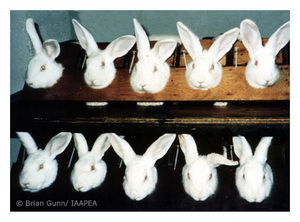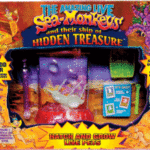The number of animals killed annually in laboratories ranges from 30 to 100 million. They die from burn and starvation experiments, weaponry testing, and space research. Add to that another 14 million killed in product tests. Over 2 million are killed in dissection classes. The species used include mice, rats, birds, dogs, cats, monkeys, and farm animals as well as tigers, seals, snakes, antelope, bats, and bears. It’s impossible to know the exact number of animals experimented on because most of the animals used in research do not have to be counted and have no legal protection whatsoever. Rats, mice, and birds are excluded from the definition of “animal” in the current Animal Welfare Act.
The minority who are protected by the Animal Welfare Act are still subject to procedures such as burning, mutilation, starvation, electrocution, irradiation, and long-term isolation. As the AWA states, “Nothing in these rules, regulations, or standards shall affect or interfere with the design, outline, or performance of actual research or experimentation by a research facility as determined by such research facility.”
About 65,000 nonhuman primates are currently used for animal research. Human and chimpanzee brains are similar in their brain circuitry, and the genes of humans and chimpanzees are 98.4% identical. Despite this similarity, other primates are not susceptible to many of the diseases that humans are, and they also have differing drug reactions.
Pounds surrender dogs and cats to laboratories in some states. People called “bunchers” pick up strays, purchase litters, and/or trap and even steal pets to sell for experiments. (NEVER say “free to good home” when you advertise to get your animals adopted. It’s the magic phrase that attracts “bunchers”. Request an adoption fee and references.)
Antiquated federal laws require that all drugs be tested on animals. Even so, according to a 2003 Frontline documentary, twelve prescription drugs had to be withdrawn by the FDA during 1997 and 2001 because of serious safety issues, and the dangerous drug problem has not abated. Cosmetics and household products are not required to be tested on animals. Nevertheless, many companies do so anyway because they’re concerned about litigation.
Sophisticated research methods such as computer models, cell cultures, and human clinical and epidemiological studies are more accurate, less expensive, less time-consuming, and more humane than animal experiments.
Presently, there are approximately 500 alternatives available to dissection for science education. Some alternatives include anatomical videos and films, models, computer programs, and slides. Despite their availability, only in a few states can students in science classes refuse to perform dissection, and the laws apply only to kindergarten through twelfth grade. In the remainder of states, students can receive a failing grade for refusing to dissect an animal.
Various professional groups such as Engineers and Scientists for Animal Rights, the Physicians Committee for Responsible Medicine, the Medical Research Modernization Committee, Psychologists for the Ethical Treatment of Animals, and the Association of Veterinarians for Animal Rights question the use of animals in experimentation, both for ethical and scientific reasons.
The three main animal methods by which cosmetics and household products are tested are the Draize eye and skin irritancy tests and the Lethal Dose toxicity test.
The first two tests require that concentrated chemical solutions be applied to the eyes or the skin of animals such as rabbits, guinea pigs, rats, mice, dogs, and cats for prolonged periods, and can cause bleeding, ulceration, blindness, burning, and blistering in these animals. Since the physiology of humans and other animals differs, the validity of these tests is very questionable.
Lethal Dose is the amount of product required to kill a percentage of test animals within a specified amount of time. This requires force feeding, forced inhaling, injections, and other exposure to cosmetics, deodorants, colognes, soaps, etc., until 50% to 100% of the animals are dead (after suffering horrible pain, convulsions, loss of motor function, or seizures). Despite the extreme animal suffering, results of these tests are ambiguous and often invalid.
Various patented mice created through biotechnology include “Oncomouse” (programmed to spontaneously develop cancer), “Flaky” (a type of mouse that develops serious skin problems), “Stargazer” (mice with an autistic disorder), and “knockout mice” (mice with one or more key genes knocked out). These unfortunate mutants can easily be ordered in bulk by lab personnel for experimentation.
In the cruel and growing field of xenotransplantation, animals are bred and killed specifically to harvest their body parts for transplantation into humans.
Biotechnology has aided and abetted factory farming. For example, broiler chickens, through selective breeding, grow in a few weeks from tiny chicks into chickens so obese they cannot stand up. The goal of PPL Therapeutics, which produced the late Dolly the sheep through cloning, is to produce an endless supply of genetically identical animals.
“Cruelty-free” in its purest form means ethically produced, i.e., neither the individual ingredients nor the finished product have been tested on animals, and the product is 100% free of animal-derived ingredients. However, the individual components may have been tested on animals, and the products may still contain animal-derived ingredients.
More than 700 cosmetics and household product companies have voluntarily announced permanent bans on animal testing. Other companies have never performed tests on animals. Lists of cruelty-free companies are available from various animal advocacy groups, including PETA.
The National Academy of Sciences recently released a report in which it proposed the gradual phasing out of animal testing on consumer products in favor of non-animal models. It stated, “Over time, the need for traditional animal testing could be greatly reduced, and possibly even eliminated someday.”
In a 1995 Associated Press survey, 67% voted that it is seldom or never right to test cosmetics on animals.
In the last twenty-five years, because of public opinion and the hard work of animal advocacy groups, there has been a reduction of approximately 50% in the use of animals in research. But there’s still a long way to go.
How can you help? Always buy cruelty-free products and write to companies that still use animals in their research stating your dissatisfaction with them. Phone or email your U.S. senator to co-sponsor the 2007 Farm Bill that recently passed the House. It contains an amendment to prevent the sale of stolen pets into animal research, ban the use of live animals in medical device sales demonstrations, and increase the fines for violations of the Animal Welfare Act.






